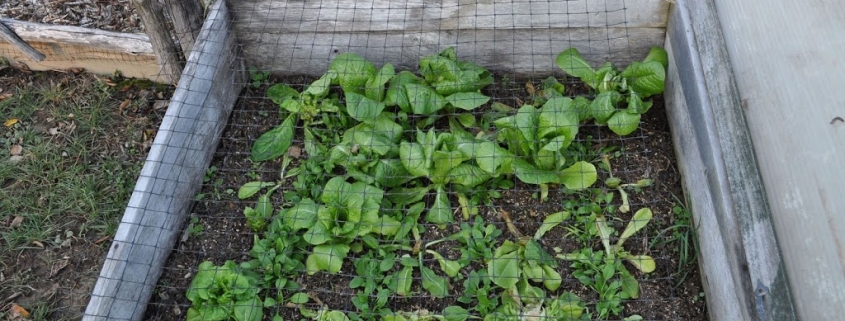SALAD TUNNELS & COLDFRAMES, AND INDOOR “PINE”
Cold has yet to throw a wrench into salads fresh from the garden — even though December 16th saw a night-time low of 12°F. Yes, the lettuce would be mush if unprotected but under the sheltering clear plastic and wooden sides of my 5 foot square cold frame, the plants are barely scathed. Just a few leaves wilted at their edges. Spinach that I sowed between the lettuce plants, for harvest after the lettuce is finished is still looking spry.
Plastic tunnels supported by wire hoops are offering almost as much cold protection over 3 garden beds. Beneath them, mustard greens, endive, and arugula don’t exactly thrive, but do survive.
A few fresh greens are even surviving out in the garden without any sort of protection whatsoever. That would include some arugula that was never covered as well as kale, what’s left of it, and mâche, the most cold-hardy of all salad greens.
Once temperatures plummet or the ground is blanketed with snow, fresh salads will come from the greenhouse, which, with night temperatures never allowed to drop below 37°F., is packed with lush greenery as if it were May.
———————————–
Update: Lettuce in the cold frame is flagging after a night-time low of 8° a few days after that 12° low. Unprotected out in the garden, only mâche and kale survive.
————————————
The holiday tree, only a half a foot tall and ornamented with 3 silver balls, is cute as a button. It’s a Norfolk Island pine (Araucaria heterophylla), a free gift I received a couple of weeks ago from a mail-order nursery. This tree will green up the darkest days of the year for year after year because it’s a tropical species that does well in the eternal warmth and somewhat dry air, in winter at least, of any home.
Over the years, the tree will lose its impishness and develop a straight, upright trunk off of which will grow relatively widely spaced, whorled tiers of horizontal branches, all clothed in green needles. With age, the plant becomes quite majestic. Too majestic, in fact, for any home. I have seen the spreading branches of this tree towering 40 feet or more over the tiled roofs of homes in tropical climates.
So what’s a gardener to do with such a plant, after years of nurturing it and watching it grow? One option, of course, is to bite the bullet and walk it over to the compost pile. Or it could be gifted to a friend with a higher ceiling, but that just shifts responsibility and puts off the inevitable. How about giving it to grandma for her front lawn in Florida?
A natural inclination for any real gardener in this situation would be to try to keep the plant going, not as its original self but in the form of a cutting. The rooted cutting, then, is genetically the same as the original plant, only a smaller version. Norfolk Island pine does root from cuttings especially, as with many conifers, if the cuttings are taken from young growth.
This plan has one problem: fixed plagiotropism. This botanical mouthful signifies the tendency for a horizontal shoot of certain plants to always retain its horizontal growth habit. Put more simply, if a cutting is rooted from one of Norfolk Island pine’s horizontal stems, that stem will always grow sideways to creep along a windowsill or wherever else the plant is growing.
The solution to this problem is to take a cutting from the leading, upright stem. It the mother plant isn’t destined for composting, though, cutting out that leading stem does ruin its form. Also, because young cuttings root best, you might end up with only one cutting, perhaps two, from that short length of young, leading stem. Not much insurance for a plant that doesn’t root all that easily.
The leading, upright stem, of a plant can have the opposite inclination: fixed orthotropism, a permanent, upright growth habit. With other plants, their plagiotropism or orthotropism may be temporary.
Not so for Norfolk Island pine’s plagiotropism. I’ll figure out how to cross that plagiotropic bridge, or not, when I come to it.
(For further discussion of topophysis, which encompasses plagiotropism an orthotropism, and related topics on plant growth, see Plant Form: An Illustrated Guide to Flowering Plant Morphology by Adrian Bell and Alan Bryan.)








Nice Post…you are all ways comming out with some grate stuff fallout 4 nexus